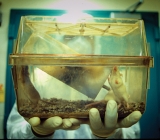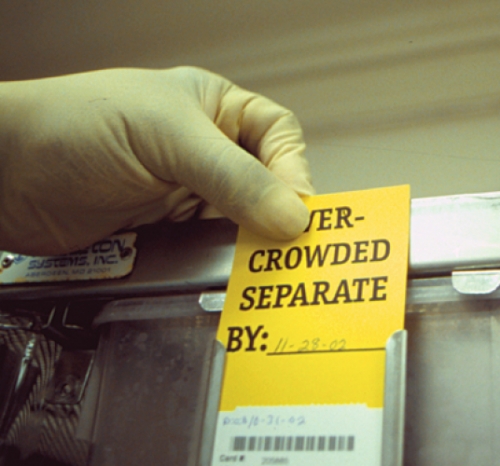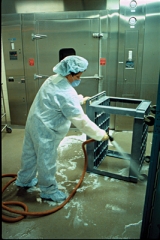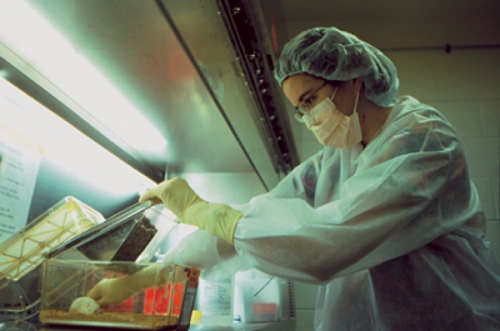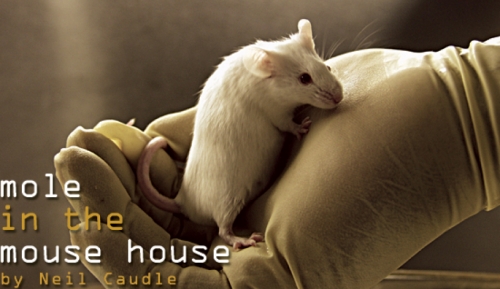During the early afternoon of April 18, 2002, I stood with reporters and photographers outside the Thurston-Bowles Building and heard three university administrators say, over the growl of buses climbing Manning Drive, that UNC-Chapel Hill had nothing to hide in its animal-research facilities. No, we would not retaliate against People for the Ethical Treatment of Animals (PETA) for planting a spy in our midst for six months or for secretly videotaping our researchers and animal-husbandry staff. No, we had no plans to conduct background checks on prospective employees to weed out the spies. And yes, members of the press could come inside our animal facilities and have a look around.
Then, with the cameras rolling, Tony Waldrop, vice chancellor for research and graduate studies, made a promise that in one breath appropriated several thousand hours from dozens of faculty, administrators, and staff. “We will,” he said, “investigate every aspect of every allegation.”
Six months later, as I write this, we have honored that promise. Our investigators have conducted dozens of interviews, reviewed hundreds of records, endured 40-some hours of murky videotape, and we have submitted our reports. Here’s the bottom line: There were some problems, a few of them serious. The university suspended the animal-research privileges of two researchers. Two others received probation, and several more have been required to modify their procedures or undergo additional training. One animal-facility manager has resigned. One new veterinary technician has been hired. We have turned over hundreds of pages of records, requested under North Carolina’s public-records law, to PETA. Two external review teams have come to campus and independently put us under the microscope. And we have shipped a report of our findings to the Office of Laboratory Animal Welfare (OLAW) in the National Institutes of Health (NIH).
End of story? No. It will take time to upgrade staff and facilities, refine our new rules and procedures, conduct new training, and confirm that our safeguards are working. And even though we have answered hard questions from reporters, from reviewers, and from OLAW, we have not yet put our answers on the record for the citizens who support this university and its research. That’s what this story is intended to do.
An Improbable Ally
The story begins, improbably enough, with Senator Jesse Helms. The University of North Carolina at Chapel Hill has not, in the past, been one of Senator Helms’ favorite institutions. But in the case of the Helms Amendment to the 2002 Farm Bill, university officials were squarely on his side. The amendment was intended to prevent provisions of the Animal Welfare Act (AWA) from being extended to mice, rats, and birds. Like other research universities accredited by the Association for the Assessment and Accreditation of Laboratory Animal Care (AAALAC), Carolina had already applied the equivalent of AWA-type coverage to rodents and birds, even though doing so was not required by law.
“A lot of people felt that extending the Farm Bill to cover rats and mice was an attempt by animal rights groups to bury us under a mountain of red tape,” says Bob Lowman, associate vice chancellor for research. “It wouldn’t have protected the animals any more. It would have just increased the regulatory burden and the cost of doing research.”
On the afternoon of April 17, when we learned that PETA would the next morning claim, publicly, that Carolina was mistreating its laboratory animals, we knew that PETA’s objective was to defeat the Helms Amendment. That press conference announcing PETA’s undercover investigation was timed to hit the media just a few days before the vote in the U.S. Senate. PETA’s website made the strategy clear: “This February, while Sen. Helms was making speeches on the floor of the United States Senate about how good rodents used in research have it, an investigator with People for the Ethical Treatment of Animals (PETA) was in Helms’ home state, working as an animal care technician inside the University of North Carolina, Chapel Hill, proving him wrong.”
On the same web site, PETA claimed that “chronic understaffing, incompetence, indifference, neglect, and outright cruelty have resulted in the denial of such basic needs as adequate space, food, water, veterinary care, and even a humane death to rats and mice at UNC.”
For those of us who are members of the Institutional Animal Care and Use Committee (IACUC), the first reaction was disbelief. Twice a year, we have inspected the animal facilities, checking cages, feed rooms, and surgery labs. Each time, we have found a small number of minor infractions and required them to be corrected. But we have never seen signs of cruelty or outright neglect. Even so, none of us was ready to write PETA’s accusations off as a publicity stunt. We would have to know the facts.
“Our job was to protect the institution,” Waldrop says, “not from PETA, and not from the press, but from whatever might have gone wrong to compromise the care of our animals, threaten our reputation, and jeopardize our ability to conduct research.”
A Spy Among Us
Before April 17, when she resigned her job as a laboratory animal technician caring for mice and rats in Thurston-Bowles, most of us had never heard of Kate Turlington. Her application for employment listed a bachelor’s degree in English and experience working with animals. In October of 2001, she began caring for mice and rats in Thurston-Bowles, giving them food and water, changing bedding, and cleaning cages. No one suspected that she was an employee of PETA who was secretly videotaping animals, researchers, and staff.
What had she found? We didn’t know. On the morning of April 18, staff from Waldrop’s office, the IACUC, and the School of Medicine quickly scanned IACUC files and talked with animal-husbandry workers. By midday, Waldrop, Provost Robert Shelton, Dean Jeffrey Houpt of the School of Medicine, and others had gathered around Houpt’s conference table to review a summary of what we had found. From February 11 to April 4, Turlington had informally reported, by email, 13 separate problems or incidents involving mice and rats. Rhonda Lewallen, an IACUC staff member, had repeatedly thanked Turlington for her reports and had sent her a copy of the university’s whistle-blower policy, assuring her that there would be no retaliation for reporting infractions. By the time Turlington resigned, the IACUC chair, Lester Kwock, and his staff had taken action on most of the issues she had revealed.
But some of those issues seemed serious, so administrators quickly agreed to acknowledge, publicly, preliminary evidence of problems in one of the university’s animal-care facilities. Until we knew the facts, they said, there would be no denials, no excuses.
So this was the gist of the message when Waldrop, Houpt, and Shelton faced reporters that afternoon outside of Thurston-Bowles. They made brief statements and fielded a few questions, and then Waldrop led three separate groups of reporters through the facilities. “We didn’t limit where the reporters could go or what they could see,” Waldrop says. “Our attitude was, this is a public institution, and we won’t hide what we do from the press.”
In general, Waldrop says, the reporters filed stories that were accurate and fair. Having no hint of a cover-up to feed on, the story faded from the headlines. In May, the U.S. Senate passed the Farm Bill with the Helms amendment intact.
Under the Gun
But if PETA had failed to derail the Helms amendment, it had nonetheless succeeded in putting the university under the gun. When Waldrop and others met in Washington with officials from OLAW, the officials made it clear that they would insist upon a formal response. Waldrop promised exactly that. He also told OLAW that he had decided to commission an independent panel of experts to investigate the IACUC and animal-care issues in general at UNC.
That idea reassured OLAW but didn’t please everybody inside the university. For some, the decision to use an outside panel implied that we had done something wrong. But as Waldrop saw it, he didn’t have a choice. “The IACUC could not credibly investigate itself,” he says, “and PETA had accused the committee of failing to enforce the rules. To restore confidence in our programs, we would need an independent review. There was no other way.”
PETA declined our request for copies of the videotapes, and we would not receive the tapes or the complete list of the allegations for weeks — until after we received them from OLAW. Waldrop decided not to wait. On Friday, April 19, just two days after PETA’s announcement, he met with the IACUC. “Investigate every allegation you find on PETA’s web site,” he said, “and report exactly what you find.”
During April and May, the committee interviewed dozens of researchers, veterinarians, and husbandry workers, often for two or three hours at a time. With very few exceptions, researchers and staff were candid, even about their own mistakes. But they also countered much of what PETA had claimed. Several recalled trying to teach Kate Turlington the difference between rodents exhibiting real illness and those that were, for instance, lethargic because of a painless, inherited condition.
But despite their belief that Turlington had misunderstood or exaggerated much of what she had reported, the animal-husbandry staff freely acknowledged that some of what she had said was true. When we asked one veteran member of the staff about her first reaction when she’d heard about the allegations, she said, “I thought, ‘Now, maybe we’ll fix what is wrong.’”
What was wrong? The most frequent complaint was that rodent cages were sometimes overcrowded. During Turlington’s brief term of employment, Carolina absorbed an unprecedented 20 percent increase in the number of laboratory rats and mice, and this growth temporarily outstripped the university’s ability to open new facilities. Other complaints were less frequent — delays in treatment when researchers couldn’t be reached, for example. And there were a few cases in which live mice somehow found their way into the dead-animal cooler, presumably because someone had not checked to confirm that animals were dead after attempting to euthanize them.
To people outside the university, especially those accustomed to thinking of rodents as pests to be trapped in the attic or ambushed by cats in the barn, problems like these may not seem to amount to a federal case. But they are, in fact, a federal case. Whatever your views of the animal-rights movement and its tactics, it has influenced agencies and institutions to adopt policies of humane treatment, not only for cuddly cats and dogs but for rodents, as well. Even so, for many of our animal-husbandry staff — people who spend their days caring for animals — policies are not the primary motive for showing the animals respect.
“If we didn’t care about the animals, this job would be impossible to take,” one husbandry worker told us.
Several of the episodes PETA described were, at first glance, alarming. In one case, PETA reported that a researcher had killed 23 mice by breaking their necks with a metal cage-card holder. When IACUC members interviewed the researcher, he explained that Turlington herself had informed him, mistakenly, that there was a pinworm infection among mice in the room and, to prevent it from spreading, he should not remove any live animals, even those scheduled for euthanasia. With no carbon-dioxide chamber in the room, the researcher euthanized the mice by cervical dislocation (a quick and fatal break of the neck) using the best implement he could find — a metal cage-card holder with a straight, narrow edge that enabled him to apply a clean break.
In another case, Turlington had repeatedly reported problems with a colony of mice whose cage cards indicated they should be euthanized. The mice had been diagnosed with a venereal infection that would not cause suffering but would render them unsuitable for research, so the veterinary staff had recommended euthanasia. But after consulting with the researchers, the staff decided to treat the infection in hopes of using the mice after all. Veterinary staff members say that they explained this to Turlington several times but that she persisted in calling the researcher, as often as six times a day, reporting that sick animals were not being euthanized.
But whatever her role in such incidents, the IACUC’s goal was not to investigate or discredit Kate Turlington. The only real question that mattered was this: Did she find any real problems we needed to fix? And the answer was yes, she did.
Broken Rules
We cannot say, without divulging confidential personnel information, specifically who broke the rules. We can say that while a few of the infractions were serious, none appeared to involve deliberate cruelty or wanton disregard for an animal’s suffering. In each case when the IACUC applied sanctions, we did so because we concluded that a researcher had used procedures that the IACUC had not approved for use at Carolina.
One of these cases, captured on a PETA videotape, involved a researcher who sprayed baby mice with alcohol then decapitated them with a pair of shears. As he works, he tells Turlington that even though the IACUC requires him to first anesthetize the baby mice by placing them on ice, he does not do so. When we viewed this segment of the videotape, the committee immediately suspended the researcher’s animal privileges pending an investigation.
But we knew that skilled decapitation with sharp shears, while repellant subject matter for a video, is considered a humane and acceptable form of euthanasia for baby mice by the American Veterinary Medical Association, which sets national standards. Because icing may cause more discomfort than the shears alone, the IACUC does not in fact recommend icing. The researcher was mistaken about the rules. Worse, he had used alcohol to chill the mice, possibly irritating their eyes. Because the IACUC had not approved this use of alcohol, and because the researcher had stated to a husbandry worker that he ignored the rules, he and his principal investigator were placed on probation for the use of animals in research.
For the IACUC, judgments like this were wrenching. Letters and phone calls from distinguished scientists urged the IACUC not to jeopardize valuable research. Debates within the committee lasted hours and traversed a wilderness of complex technical and ethical issues. When the IACUC voted to suspend animal privileges for two researchers who had used an unauthorized blood-sampling procedure on mice, the committee did so knowing that the sanctions would compel the university to notify the agencies funding the work.
“As a scientist, you can see a whole set of scientific reasons for doing things the way they were done,” says one IACUC member. “And you can see that there was probably never any intention to mistreat any animals. So it’s very hard to make a decision that could, in effect, damage somebody’s career. But it’s our job to protect the animals and enforce the rules. If we don’t do that job, then maybe the NIH steps in and takes all of our animals away. And what would that do to all of the other researchers who followed the rules?”
Through the Wringer
Just as we emerged from these decisions, two independent review teams arrived in rapid succession. The first was Waldrop’s panel of three independent, nationally recognized experts in animal care, who spent weeks reviewing records and then came to campus for inspections and interviews. Their report, which arrived a few months later, worked us over pretty well — not because the team had found any evidence of cruelty or neglect but because, in their view, Carolina’s safeguards had sprung a few leaks. Staffing and supervision were inadequate, they said; communication breakdowns were too frequent; and research staff did not always know the exact terms and provisions of their project’s animal-use protocols.
One month after the first review team left town, a second descended on campus. A panel of reviewers from AAALAC spent several days on campus in July, putting animal-care personnel through the wringer all over again. This time, the focus was less on organizational deficiencies and more on the day-to-day details of animal care. In November, AAALAC renewed the university’s accreditation contingent upon several improvements in policies, facilities, and procedures.
The third and final external review — OLAW’s response to our findings — is still under way. In September, the university submitted its 44-page report. In December, OLAW requested further information and additional changes in policies and procedures. No one here believes that OLAW will suspend the university’s animal-research privileges, but the office could decide to impose lesser sanctions or require further study.
Meanwhile, the university continues to put its animal program in order. In August, September, and October, the IACUC approved new policies governing blood-sampling methods and euthanasia practices. And there are more to come. But for members of the IACUC, whose detective work provided much of the substance of the report to OLAW, it seems a shame that PETA’s attempts to defeat the Helms amendment should have been allowed to exact such a high price.
“If you take that same level of effort and put it into research or teaching, you could do something significant to help society,” one IACUC member says. “Yes, we had some problems, and yes, we will fix them. But none of those problems was serious enough to justify what this place has been through.”
Waldrop takes a somewhat different view. “The public, the press, and the government all hold us to the highest standards of ethical conduct,” he says, “and I wouldn’t have it any other way. We have been doing a good job of caring for our animals. But we could have done a better job. And now we will.”
Neil Caudle was the editor of Endeavors for fifteen years.


